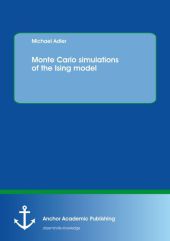 Neuerscheinungen 2016Stand: 2020-02-01 |
Schnellsuche
ISBN/Stichwort/Autor
|
Herderstraße 10
10625 Berlin
Tel.: 030 315 714 16
Fax 030 315 714 14
info@buchspektrum.de |

Michael Adler
Monte Carlo simulations of the Ising model
2016. 104 S. 23 Abb. 220 mm
Verlag/Jahr: ANCHOR ACADEMIC PUBLISHING 2016
ISBN: 3-9548987-9-9 (3954898799)
Neue ISBN: 978-3-9548987-9-4 (9783954898794)
Preis und Lieferzeit: Bitte klicken
In this book, the thermodynamic observables of the classical one- and two-dimensional ferromagnetic and antiferromagnetic Ising models on a square lattice are simulated, especially at the phase transitions (if applicable) using the classical Monte Carlo algorithm of Metropolis. Finite size effects and the influence of an external magnetic field are described. The critical temperature of the 2d ferromagnetic Ising model is obtained using finite size scaling. Before presenting the Ising model, the basic concepts of statistical mechanics are recapped. Furthermore, the general principles of Monte Carlo methods are explained.
Text sample:
Chapter 2.2.4. Initialization bias:
In the beginning of our simulation the system is out of equilibrium. As long as the system is out of equilibrium our data will have a systematic error since the equilibrium distribution was not yet reached. After a time _eq the system is in equilibrium. Unfortunately in general we do not know this time. One possibility is to estimate the time is by plotting observables like magnetization, internal energy...as functions of time in one diagram. After a sufficient time we expect that the observables do not change. Now they have reached approximately equilibrium. But it may be just a local minimum. Therefore weŽll perform at least two simulations with different initial conditions, e.g. T=0 and T=_. WeŽll plot the respective observables of both simulations in one diagram. The cross-over point indicates the equilibration time. This has to be done for every observable, i.e. two observables in one plot since different equilibration times may exist for different observables. There is still the danger that the system reached only metastability. Therefore it is advisable to perform simulations in the in these regions with different initial values and test the consistency. Most Monte Carlo simulations simulations display metastability near a first-order transition. If we know the equilibration time weŽll discard date performed before equilibration was achieved. The statistical errors associated with an out-of-equilibrium system are of order _/n as opposed to statistical errors after the initial transient being of order (_/n)1/2.
2.2.5. Autocorrelation in equilibrium:
Since Monte Carlo methods sample new states from old states there is a high correlation between subsequent states. To get rid of this correlation we have to wait a time _auto before taking the next data point so the points are uncorrelated. This means that we have only n/2_auto independent data points if we conduct a run of length n.
To quantify the correlation between a given observable O at time t and the same observable at time t+t0 the autocorellation function is used: [...].
Sometimes eqn. (2.21) is used without the normalization factor, this is the auto covariance. It follows from eqn. (2.21) that the correlation is positive if O(t) and O(t+t0) fluctuate in the same direction. It is negative if they fluctuate in the opposite direction, they are anticorrelated. It may be shown that CO~exp(_t/_auto). One possibility to obtain _auto once we know the autocorrelation function is to plot it as function of time on semi-logarithmic axes. The slope which can be obtained using a linear fit is _auto.
2.3. Analyzing the data - Tc and more:
Once the Monte Carlo simulation is finished the most important task has yet to be done. The data need to be analyzed. To achieve this aim we first have to find the critical temperature Tc. With this temperature we can calculate the critical exponents.
2.3.1. Finite size scaling and the Binder ratio:
The basic idea is that in the vicinity of the critical temperature the correlation length _ diverges; i.e. the typical size of clusters of correlated spins explodes. Due to the finite size of the lattice there can be no strictly mathematical divergence. Once the dimension of the system L is reached the correlation length is cut off. It can be shown that observables (here m) near Tc and for large L can be written: [...].


